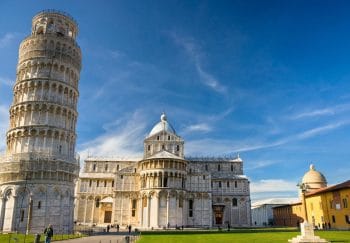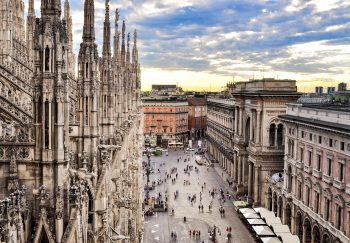The Flavian Amphitheater (also known as the Roman Colosseum) is the most iconic symbol of Rome. The Flavian Dynasty, which included Emperors Vespasian and Titus, built it over 25 years during the first century AD. It is still the largest open-air amphitheatre ever constructed. It was built almost 2,000 years ago and served the same purpose as modern amphitheatres: to display large public spectacles.
Its purpose was modern as was its architecture and size. The ancient Colosseum was capable of holding between 50,000 to 80,000 spectators. Its size is comparable to Manchester United’s Old Trafford and the Mile High Stadium in Denver.
It had well-designed exits that could empty entire venues in minutes. There were trapdoors on the arena floor that allowed spectators to experience “special effects”. A giant awning protected them from the rain. It is a reminder of how similar we humans can be to the Ancient Roman Colosseum.
The Roman Colosseum: What are you looking?
The Facade of the Colosseum
The Amphitheater’s outer wall is made of more than 100,000 cubic meters of travertine, without any concrete. Instead, 300 tons of iron clamps held the stones together. You won’t find any iron or other metals holding together the Colosseum today because it was all plucked at different points in the city’s history, when metal was scarce or expensive.
After the Colosseum had fallen into disuse, stones were also taken out and repurposed. There were 80 exits and entrances that could be used to allow large groups of people to quickly get in and out. The grandest arches were reserved only for the emperors or nobility. However, most people would have entered and exited through passages called vomitoria, which in Latin means rapid discharge. It’s also where the English word “vomit” is found, which is not surprising.
The Colosseum Underground
When you step out onto the Colosseum’s floor, the first thing you will notice is the absence of a floor. No, really. It was probably made of wooden planks, which were likely covered with sand to provide traction. Nothing remains today. Instead, the floor is now exposed as a network of tunnels and cells. These are officially known as the Hypogeum but they are often referred to simply as the Colosseum underground.
The Colosseum Underground was where gladiators were kept before they were ready to fight. Wild animals were also held there, which were imported from North Africa. They were then released during shows called Venationes in which a specialized gladiator hunted them.
You should be on the lookout for trap doors that could have been used to raise or lower the arena floor to create crowd pleasing effects. Although the exact nature of these effects is unknown, they appear to have played an important role in the games.
The Colossus
Colosseum actually refers to Rome’s most iconic monument that no one has ever seen. “Colosseum” literally translates to ” Location of the Colossus.” But, who or what was this Colossus_? The Colosseum was home to a huge bronze statue of Emperor Nero. It was eventually destroyed and melted for metal in the eighteenth century.
It was originally located at the entrance to his Domus Aurea pleasure complex, which had 300 rooms and once dominated large areas of the Roman Forum. It was believed to have risen between 30 and 35 meters, and needed a team of elephants for it to move. However, it never sat inside the Colosseum and eventually settled near it.
The statue was destroyed sometime in the 8th Century, but it was what inspired the phrase “As long the Colossus remains, Rome will remain; when it falls it will also fall.” The phrase was first coined in an English writing style by The Venerable Bede. Lord Byron later adapted it in his famous poem Childe Harold’s Pilgrimage to make it fit the Colosseum.
Tips for Visiting the Colosseum
Opening Times
Every day: 9.00am to 7.00pm, with the last admission an hour before closing. You can find more information at the Coop Culture or the official ticket office.
Sunday, 5 September 2021 The Colosseum closes @ 5:00 PM for the hosting of a G20 Event
It closes on December 25th and January 1st.
Rules
Access to the site will be restricted to those who have one of the Covid-19 Green Pass certificates and a valid identification document with reference to current government provisions. This is to deal with the Covid19 epidemiological emergency.
Children under 12 years old and children exempted by appropriate medical certification are not eligible for COVID-19 green certification.
You will not be allowed to enter the Parco areas sites if you don’t have a Green Pass or a valid ID document. Your ticket will also not be refunded.
Visitors must wear a mask to their face and must arrive with his/her access ticket at least 15 minutes prior to the scheduled access time.
Keep in mind, however, that small bags and medium-sized backpacks are allowed to enter the Colosseum. However, any large bags, backpacks or heavy bags are strictly forbidden. You must first open your bag and let security inspect it before you can enter. You should arrive at least 30 minutes prior to the Colosseum’s reservation time.
Access to the Colosseum is not very good. This is important to know as wheelchair-bound visitors will be limited to the ground floor.
Plaques and additional information are not available at the Ancient Roman Colosseum. If you want to truly appreciate what you see, you can read up beforehand, rent an audio guide or join a guided tour.
Join our VIP Colosseum Underground Tour to delve into the Colosseum’s history and hear the stories of gladiators from an expert guide.
How to Purchase Colosseum Tickets
Tickets to the Colosseum can be purchased online or by calling Coop Culture’s call centre.
You can also purchase a Roma Pass. You can also buy a Roma Pass, which gives you access to many of Rome’s most popular attractions. They are a favorite among archeologists and history buffs. More details here: https://www.romapass.it/?l=en
The Best Times to Visit the Colosseum
The Colosseum is most popular during the off-season (November through April), but it can still be crowded. Normal rain will not close the Colosseum, but adverse weather could cause it to close for the day.
High season visitors can usually expect good weather and bigger crowds. This is why booking tickets in advance is so important, especially if you plan to visit between May-October.











